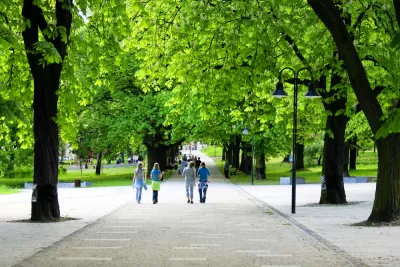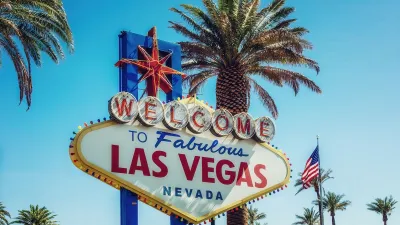More and more evidence has emerged in recent years about the many benefits of trees in urban environments. Every now and then, however, a study finds evidence that tress might not always be as benevolent as they seem.

Rob MacKenzie shares insight into new research that might complicate assumptions about the role of trees in urban environments. The problem, writes MacKenzie: "some recent studies have suggested that trees may in fact worsen urban air quality by trapping pollutants at street level."
It's not that simple, of course, and Mackenzie insists that a closer look at the evidence "can help us come to a more nuanced understanding of the impacts of trees on our urban environment."
It all has to do with effect of the cocktail of buildings, structures, and landscapes that make up the city, of which trees have a unique role to play. "Trees affect the urban environment in several subtle ways. From altering air flows, to collecting pollution deposits, to affecting the chemical make up of the atmosphere, their impacts are both pervasive and difficult to pinpoint," writes MacKenzie.
So while MacKenzie goes into more detail about the several different pollution processes tress take part in, no studies have so far managed to put all the pieces of a city together. In lieu of a comprehensive model, MacKenzie uses the article as an opportunity to suggest strategies for piecing together different studies to create a more complete picture.
For more on the complex questions posed by the role of trees in the urban environment, an earlier article by John Gallagher first raised some of the same discussion points.
FULL STORY: Do trees really help clear the air in our cities?

Alabama: Trump Terminates Settlements for Black Communities Harmed By Raw Sewage
Trump deemed the landmark civil rights agreement “illegal DEI and environmental justice policy.”

Planetizen Federal Action Tracker
A weekly monitor of how Trump’s orders and actions are impacting planners and planning in America.

Why Should We Subsidize Public Transportation?
Many public transit agencies face financial stress due to rising costs, declining fare revenue, and declining subsidies. Transit advocates must provide a strong business case for increasing public transit funding.

Understanding Road Diets
An explainer from Momentum highlights the advantages of reducing vehicle lanes in favor of more bike, transit, and pedestrian infrastructure.

New California Law Regulates Warehouse Pollution
A new law tightens building and emissions regulations for large distribution warehouses to mitigate air pollution and traffic in surrounding communities.

Phoenix Announces Opening Date for Light Rail Extension
The South Central extension will connect South Phoenix to downtown and other major hubs starting on June 7.
Urban Design for Planners 1: Software Tools
This six-course series explores essential urban design concepts using open source software and equips planners with the tools they need to participate fully in the urban design process.
Planning for Universal Design
Learn the tools for implementing Universal Design in planning regulations.
Caltrans
Smith Gee Studio
Institute for Housing and Urban Development Studies (IHS)
City of Grandview
Harvard GSD Executive Education
Toledo-Lucas County Plan Commissions
Salt Lake City
NYU Wagner Graduate School of Public Service





























